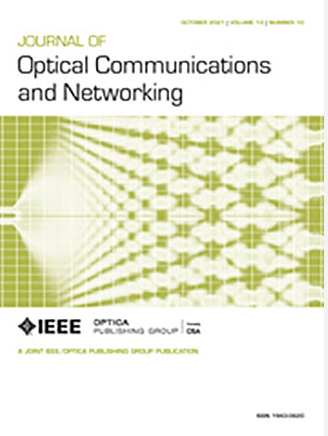Efficient verification algorithm for topology and quality of optical fibers in optical-circuit-switched data center networks
IF 4.3
2区 计算机科学
Q1 COMPUTER SCIENCE, HARDWARE & ARCHITECTURE
引用次数: 0
Abstract
The introduction of optical circuit switches (OCSs) has enabled the implementation of capacity- and energy-efficient networks in production data centers. To correctly operate optical-circuit-switched data center networks (OCS DCNs), fibers between pairs of terminals (e.g., servers or top-of-rack switches) and OCSs should be verified before starting operations; otherwise, unexpected failures during operations could occur. However, this task is difficult because OCSs cannot use topology discovery or link-monitoring functions, which are only available on electrical packet switches. We thus studied a fiber-topology and quality verification (FTQV) problem for OCS DCNs. Though a previous study inspected fibers between pairs of OCSs in hierarchical OCS DCNs using only one dedicated tester for fiber probing, making the process time-consuming, we consider verifying fibers between pairs of terminals and OCSs by using the digital diagnostic monitoring (DDM) function at multiple terminals. We thus developed new theories, to the best of our knowledge, for correctly carrying out FTQV even when parallel probes are sent and then designed an algorithm that efficiently solves the FTQV problem with near-optimal inspection steps. We also theoretically analyzed the conditions of detectable and undetectable malfunctioning fibers given the maximum measurement error of the DDM function. Experimental results indicate the correctness of our theoretical analysis and superior performance of our algorithm; it completes FTQV at most 93.0 times faster than a baseline algorithm. The feasibility of our algorithm was also demonstrated through evaluations on an actual network.光电路交换数据中心网络中光纤拓扑和质量的有效验证算法
光学电路交换机(ocs)的引入使得在生产数据中心实施容量和节能网络成为可能。为了正确操作光电路交换数据中心网络(OCS DCNs),在开始操作之前,应验证终端对(例如,服务器或机架顶部交换机)和OCS之间的光纤;否则,可能会在操作过程中出现意想不到的故障。但是,由于OCSs无法使用拓扑发现和链路监控功能,因此这项任务比较困难,这些功能只有在电分组交换机上才能使用。因此,我们研究了OCS DCNs的光纤拓扑和质量验证(FTQV)问题。虽然之前的研究只使用一个专用的光纤探测测试仪来检测分层OCS DCNs中OCS对之间的光纤,使得这个过程非常耗时,但我们考虑在多个终端上使用数字诊断监测(DDM)功能来验证终端对和OCS之间的光纤。因此,我们开发了新的理论,尽我们所知,即使在发送并行探针时也能正确执行FTQV,然后设计了一种算法,以接近最佳的检查步骤有效地解决FTQV问题。在给定DDM函数最大测量误差的情况下,从理论上分析了故障光纤可检测和不可检测的情况。实验结果表明了理论分析的正确性和算法的优越性;它完成FTQV的速度最多比基准算法快93.0倍。通过对实际网络的评估,验证了算法的可行性。
本文章由计算机程序翻译,如有差异,请以英文原文为准。
求助全文
约1分钟内获得全文
求助全文
来源期刊
CiteScore
9.40
自引率
16.00%
发文量
104
审稿时长
4 months
期刊介绍:
The scope of the Journal includes advances in the state-of-the-art of optical networking science, technology, and engineering. Both theoretical contributions (including new techniques, concepts, analyses, and economic studies) and practical contributions (including optical networking experiments, prototypes, and new applications) are encouraged. Subareas of interest include the architecture and design of optical networks, optical network survivability and security, software-defined optical networking, elastic optical networks, data and control plane advances, network management related innovation, and optical access networks. Enabling technologies and their applications are suitable topics only if the results are shown to directly impact optical networking beyond simple point-to-point networks.

 求助内容:
求助内容: 应助结果提醒方式:
应助结果提醒方式:


